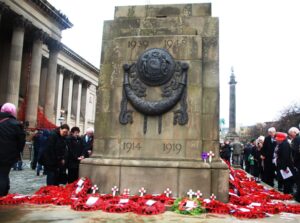
A historic landmark trail that reveals stories from the city’s World War I experiences has been developed by the council alongside National Museums Liverpool.
The ‘Liverpool Remembers Trail’ has been designed to complement the unveiling of the ‘Weeping Window’ display that arrived at St George’s Hall at the weekend.
There are 21 sites spread across the city, which each explore a different story about Liverpool’s connection to the Great War. The council hopes that the trail will attract people of all ages to learn about the stories of service and sacrifice made by the people of Liverpool during WWI.
The trail stops include memorials such as the Liverpool Cenotaph on St George’s Hall Plateau and the Unknown Soldier on Exchange Flags. Many of the buildings across Liverpool’s skyline, including the Royal Liver Building and the Cunard Building, are also featured along the route.
Karen O’Rourke, curator of Urban and Military History at the Museum of Liverpool, provided local content and pictures for the trail. She told JMU Journalism: “There were originally 23 stories, because of location restraints we had to reduce this number to 21. But I could easily have written the same again several times over as Merseyside has such a rich history.
“Because of the connection to the Weeping Window installation, the trail is very much focused on Remembrance and commemoration. It was quite difficult to get a balance so that it is not all about loss, but it is also definitely not ‘celebrating’ war.”
Liverpool’s geographical location and maritime links meant that the city played a pivotal part during the war. Karen said: “All port cities became key sites in the war effort. The west coast ports, including Liverpool, were possibly the most important.
“The Chinese Labour Corps travelled across Canada and through Liverpool to reach the front. Later in the war, American troops travelled through Liverpool and there was a base in Knotty Ash and an American hospital in Mossley Hill.”
In addition to supplies, the numbers of soldiers recruited from the Merseyside region were extraordinary. Karen explained: “Over 100,000 men from the city alone are thought to have enlisted. The story of the Pals is well documented and a good example of a rush to enlist, but they are just a handful of battalions from a much larger story. We have tried to bring the city and its people to life.”

